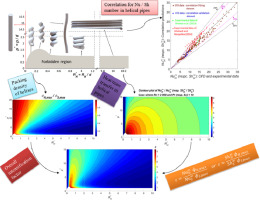当前位置:
X-MOL 学术
›
Int. J. Heat Mass Transf.
›
论文详情
Our official English website, www.x-mol.net, welcomes your feedback! (Note: you will need to create a separate account there.)
Optimal design of helical heat/mass exchangers under laminar flow: CFD investigation and correlations for maximal transfer efficiency and process intensification performances
International Journal of Heat and Mass Transfer ( IF 5.2 ) Pub Date : 2020-06-01 , DOI: 10.1016/j.ijheatmasstransfer.2020.119610 Omran Abushammala , Rainier Hreiz , Cécile Lemaître , Éric Favre
International Journal of Heat and Mass Transfer ( IF 5.2 ) Pub Date : 2020-06-01 , DOI: 10.1016/j.ijheatmasstransfer.2020.119610 Omran Abushammala , Rainier Hreiz , Cécile Lemaître , Éric Favre

|
Abstract Highly curved helical pipes (HCHPs) offer tremendous potentialities for intensified heat/mass transfer performances as they generate intense Dean-type vortices. However, these designs have not been explored so far in the literature, probably because they are difficult to build using traditional manufacturing techniques. Nowadays, thanks to a witnessed progress in 3D-printing, the fabrication of HCHPs has become achievable. Therefore, investigating their performance in terms of heat and mass transfer intensification presents significant interest from both academic and industrial points of view. In this paper, CFD simulations are carried out to determine the heat/mass transfer efficiency in helical pipes (particularly highly curved ones) under laminar flow conditions. The packing density (i.e. interfacial area) of these geometries is evaluated using a CAD software. The results reveal that HCHPs not only allow achieving much higher transfer rates than straight and classical helical pipes, but they can also be densely packed. Therefore, when appropriate designs are selected, impressive process intensification factors are achievable, with up to 8-fold volume reductions. Finally, correlations are developed for evaluating the interfacial area and the heat/mass transfer efficiency in classical and highly curved helical pipes. In future works, these correlations will be used in model-based optimization for determining the optimal designs of helically coiled heat/mass exchangers.
中文翻译:

层流下螺旋热/质交换器的优化设计:CFD 研究以及最大传递效率和过程强化性能的相关性
摘要 高度弯曲的螺旋管 (HCHP) 为增强的传热/传质性能提供了巨大的潜力,因为它们会产生强烈的迪安型涡流。然而,到目前为止,文献中尚未探讨这些设计,可能是因为它们难以使用传统制造技术进行构建。如今,由于 3D 打印技术的进步,HCHP 的制造已成为可能。因此,从学术和工业的角度来看,研究它们在传热和传质强化方面的性能表现出极大的兴趣。在本文中,CFD 模拟用于确定螺旋管(特别是高度弯曲的管)在层流条件下的传热/传质效率。堆积密度(即 使用 CAD 软件评估这些几何形状的界面面积。结果表明,与直管和经典螺旋管相比,HCHP 不仅可以实现更高的传输速率,而且还可以密集填充。因此,选择适当的设计时,可实现令人印象深刻的过程强化因子,体积减少至多8倍。最后,开发了用于评估经典和高度弯曲螺旋管的界面面积和传热/传质效率的相关性。在未来的工作中,这些相关性将用于基于模型的优化,以确定螺旋盘管热/质量交换器的最佳设计。但它们也可以密集包装。因此,选择适当的设计时,可实现令人印象深刻的过程强化因子,体积减少至多8倍。最后,开发了用于评估经典和高度弯曲螺旋管的界面面积和传热/传质效率的相关性。在未来的工作中,这些相关性将用于基于模型的优化,以确定螺旋盘管热/质量交换器的最佳设计。但它们也可以密集包装。因此,选择适当的设计时,可实现令人印象深刻的过程强化因子,体积减少至多8倍。最后,开发了用于评估经典和高度弯曲螺旋管的界面面积和传热/传质效率的相关性。在未来的工作中,这些相关性将用于基于模型的优化,以确定螺旋盘管热/质量交换器的最佳设计。
更新日期:2020-06-01
中文翻译:

层流下螺旋热/质交换器的优化设计:CFD 研究以及最大传递效率和过程强化性能的相关性
摘要 高度弯曲的螺旋管 (HCHP) 为增强的传热/传质性能提供了巨大的潜力,因为它们会产生强烈的迪安型涡流。然而,到目前为止,文献中尚未探讨这些设计,可能是因为它们难以使用传统制造技术进行构建。如今,由于 3D 打印技术的进步,HCHP 的制造已成为可能。因此,从学术和工业的角度来看,研究它们在传热和传质强化方面的性能表现出极大的兴趣。在本文中,CFD 模拟用于确定螺旋管(特别是高度弯曲的管)在层流条件下的传热/传质效率。堆积密度(即 使用 CAD 软件评估这些几何形状的界面面积。结果表明,与直管和经典螺旋管相比,HCHP 不仅可以实现更高的传输速率,而且还可以密集填充。因此,选择适当的设计时,可实现令人印象深刻的过程强化因子,体积减少至多8倍。最后,开发了用于评估经典和高度弯曲螺旋管的界面面积和传热/传质效率的相关性。在未来的工作中,这些相关性将用于基于模型的优化,以确定螺旋盘管热/质量交换器的最佳设计。但它们也可以密集包装。因此,选择适当的设计时,可实现令人印象深刻的过程强化因子,体积减少至多8倍。最后,开发了用于评估经典和高度弯曲螺旋管的界面面积和传热/传质效率的相关性。在未来的工作中,这些相关性将用于基于模型的优化,以确定螺旋盘管热/质量交换器的最佳设计。但它们也可以密集包装。因此,选择适当的设计时,可实现令人印象深刻的过程强化因子,体积减少至多8倍。最后,开发了用于评估经典和高度弯曲螺旋管的界面面积和传热/传质效率的相关性。在未来的工作中,这些相关性将用于基于模型的优化,以确定螺旋盘管热/质量交换器的最佳设计。



























 京公网安备 11010802027423号
京公网安备 11010802027423号